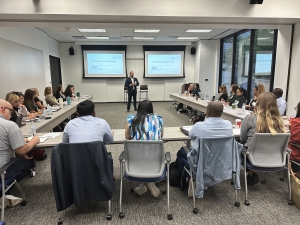Immediate response capabilities, increased preparedness and reconfiguring for resiliency were at the core of the discussion during a PESA webinar hosted on April 23. Participants from more than 50 companies joined to hear insights from Clay Colvin, Principal Director, Accenture, who discussed the impact the COVID-19 pandemic has had on supply chains and how to navigate the disruption now and in the future. Crafted for the OFS industry, his updated presentation echoed portions of a report Accenture released in March, Building supply chain resilience: What to do now and next during COVID-19.
Colvin shared a framework for creating an environment and the capabilities within an organization to better position for a disruption. It begins with visibility and mobilization by establishing a command center and initializing a market response plan. This piece includes implementing new rules of governance and daily operations that have not been traditionally executed.
Mobilizing evolves into sensing and prioritizing new risks, which includes determining implications to a company’s supply chain components including its products, services and ecosystem. Analysis of what-if situations follows, as well as deploying digital and organizational capabilities to analyzed massive amounts of new data and inputs and quickly determine what decisions need to be made.
The final piece, Colvin said, is configuring all the elements and readjusting the organization’s supply chain to be in a better position to respond in the future.
MATURING THE RAPID RESPONSE
Colvin then walked through three key components of maturing the rapid response. This path focuses on how a company evolves during a critical disruption, addressing immediate reactions through new ways of operating the business.
TRIAGE AND CONTAIN
The “triage and contain” stage looks at how to “stop the bleeding.” This includes assessing the situation and identifying risks and cost implications that could have an impact on the company. This requires leadership to identify primary issues, respond quickly, and be ready to adjust and adapt as the situation progresses.
Establishing visibility throughout the entire supply chain by creating an end-to-end common view is critical, Colvin said. This helps identify critical actions an organization must take across the network. Once visibility is in place, risks such as sourcing product flow, operations scheduling, contract demands, and network capacity can be prioritized.
Impact assessments follow, which focus on decision making, analyzing data and proposing recommendations to leadership in a timely fashion. Lastly, organizations can activate the initial response, looking at key internal components such as safety, remote workforce, technology and trade regulations. Companies need to be aware of how they’re affected internally as well as how their customers and suppliers are handling the disruption.
STABILIZE AND SUSTAIN
As risks and constraints are assessed, monitored and mitigated, organizations need to determine how to function in an altered operating model. This transformation looks at how to pivot to a new normal by digesting new intelligence, implementing new action plans, establishing financial preservation and building resiliency within the new operating model.
During this phase organizations can focus on using information to gain insights on customer behaviors, order fulfillment and movement of materials, analyzing the impact and working within cross-functional teams. Monitoring and addressing ongoing risk, another element to this phase, develops a fuller understanding of an organization’s current status and helps consistently implement protocols.
Financial preservation actions such as improving an organization’s cash position during a crisis like COVID-19 is critical. Repositioning inventory and reducing DSO can move the needle significantly especially during times of customer order changes, so being tied into finance and accounting is essential. Finally, building demand driven resilience rounds out this phase which focuses on looking forward within the new operating model.
OPERATE THE NEW NORMAL AND BUILD RESILIENCE
The final piece of the evolution looks at how companies are restructuring their internal organizations while keeping the customer at the forefront. Cross-functional, collaborative approaches are being implemented and organizations are being thoughtful of the skill sets and capabilities of their workforce, now and for the long term.
At this stage, it’s important for companies to lean out processes, make faster decisions and predict future disruptions using internal and external market intelligence, Colvin said. Risk operating groups can track risk in real time with different sets of data than before. Leveraging automated workflows for certain processes can help an organization stay on track and elevate risk response.
Colvin closed by addressing purpose and social responsibility and preserving the broader ecosystem in the current environment. Organizations are taking a close look at workforces and the wellbeing of employees, suppliers and partners. Reskilling and upskilling employees to provide better collaboration across the company is key. Externally, companies are considering the effect of the pandemic on smaller organizations and are allowing for greater flexibility and nontraditional order fulfillment as a means to support these entities.
Colvin’s final message to the audience was summarized by two key components around supply chain resilience and positioning for future success: having the ability to mange disruption and recovering operational capability after disruption occurs.
[gdlr_button href=”https://energyworkforce.org/wp-content/uploads/2020/04/Accenture-PoV-Supply-Chain-Resilience-PESA-2020-04-23.pdf” target=”new” size=”medium” background=”#3d90c7″ color=”#ffffff”]DOWNLOAD THE PRESENTATION[/gdlr_button]
If you would like to join future supply chain calls, please contact Senior Director Membership Services Peggy Helfert.




